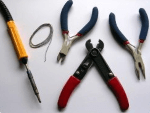Beginners Guide - Basic Tools
You'll need a few basic tools to complete your first project, however don't go mad and buy every tool under the sun. The most essential items you will need are a soldering iron and some solder - this is not normally provided with kits. You will also need some wire-cutters, wire-strippers and a pair of small pliers. Other items are also useful although not essential. Many suppliers sell basic tool kits, these could be better value but check they contain the tools you need.
Here's a list of essential / optional tools. I have included Maplin order codes where possible, although alternatives are available from other suppliers:
Essentials

Soldering iron - Antex 18 Watt type CS (code FY62S) or 25 Watt type XS (code FR12N). The XS model is probably better due to the higher power, but it is physically larger, and the 'bit' (the business end) is bigger. A full range of bits is available if you later decide you want a smaller bit. If you decide not to buy a stand (see below), you will also need a natural sponge to clean the bit on (a synthetic sponge will melt).
Solder - Solder comes in different thicknesses, 22SWG is thinner than 18SWG and is better for small joints. New legislation (RoHS) prevents the use of lead based solder in most commercially built electronic equipment, but you can still use it for home project construction. However this does mean some suppliers no longer stock leaded solder, but a small tube of lead-free solder (Maplin code N35BJ) should be fine. Alternatively last time I checked B&Q sold small tubes of tin/lead solder. Click here for more details on the RoHS directive.
Wire Cutters - Also called 'side cutters' these are used for cutting component leads close to the circuit board after soldering. I suggest Maplin's 'Snip Cutter' (code JH20W) or '155mm Side Cutters' (code GW49D).
Wire Strippers - These are used to strip the insulation off wires you connect to your circuit. Strangely Maplin seem to have stopped stocking their simple 'Model 9' and their alternatives are all more heavy-duty (code FT44X might be suitable). You might need to try another supplier or a local shop for these. More complicated models aren't really worth the money for occasional hobby use.
Pliers - Used for bending wires on components to fit into circuit board. These MUST be small - not the ones you use for plumbing! The range of pliers available is vast - I suggest the 'Miniature Long Nose Pliers' (code RL84F) or similar.
Optional Extras

Screwdrivers - Needed for some kits, not for others. A small straight type (code RM00A) and Medium cross - point type (code RM14Q) are most useful. You might well already have some suitable ones, so check what you need before buying
Soldering iron stand - Stops you burning yourself, the lead or the table when the iron is not in use! Also has a sponge to clean the iron. (code FR20W)
Desoldering tool - Useful when you need to remove a solder joint for whatever reason. They work by sucking the molten solder into the pump, away from the joint. (code FR26D)
Wooden board - If you don't have a workbench, use an old piece of shelving or similar to protect your table. If you don't have a board, buy a piece of chipboard or conti - board.
Test equipment - The only item of test equipment that's worth considering at this stage is a multimeter. A basic kit shouldn't require you to have one, although if it doesn't work one can be useful to find out what's wrong. If you do get one, choose a reasonable model so you don't 'outgrow' it too soon! I suggest Maplin's 'PG10B' model (code GW18U). However, these are quite expensive, and not essential at this stage. Basic multimeters are available for under £10.
Now we've sorted out tools, lets look at the basic techniques needed to assemble the kit, starting with soldering.




